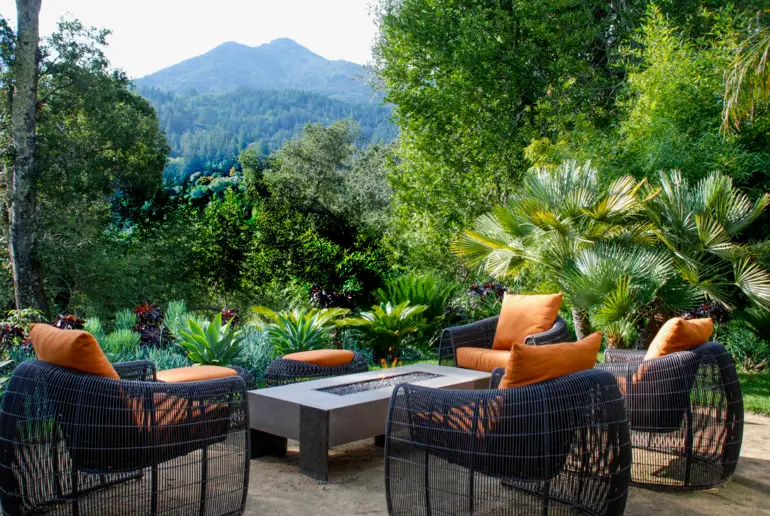In Kentfield, a temperate Zone 17 hillside is now a lush wonderland.
“MY FATHER WAS A CONTRACTOR who painted murals on the walls of our home in the San Fernando Valley,” Barbara MacDonald, 64, who is now a Bay Area psychiatrist, recalls. “My mom grew up in Hawaii so there were exotic birds, trees and bamboo depicted. We had a real lava rock fireplace and slate floors.”
Fast-forward to the ’80s, when MacDonald and her psychologist husband Peter Howard moved into their L-shaped 1940s Kent Woodlands home. They were pleased that they had underground springs to keep the hillside property green even in the driest years. What they didn’t know was that the springs were also undermining their home. “Water was wicking into the walls,” MacDonald says.
To fix all that, they had to embark on a massive reconstruction in 2003, but they got to modernize the house, add bigger windows and bring in more light. However, the garden on the roughly one-acre property never quite recovered.
“Apart from the oak trees, there was just a crabgrass-y lawn in the front yard and a downslope with weeds in the back,” MacDonald says.
Then, about eight years ago, they decided to spring for six mature olive trees from Crown, a tree farm an hour north of Sacramento, and Marin-based Timothy O’Shea, who cut his gardening teeth at the Green Gulch Zen Center before studying landscape architecture at UC Davis, got to install them.
“Initially, we thought the project we would take on was so small in scope that we might not need a landscape designer,” MacDonald, who is a plant enthusiast, says. But as O’Shea, who has since co-launched the landscape design firm Green 17 Design (inspired by the Bay Area’s Zone 17 growing designation), laid out tantalizing possibilities, the project grew and they began to install a new garden.
“Their blacktop driveway, small parking lot and lawn looked pitiful,” O’Shea remembers. “We transformed it all.”
After the trees were in, a hedge was grown to screen off the cars; then a cascading fountain designed by artist Hugo McCloud went into the front yard, followed by a collection of large showy agaves. A terrace outside the pool house became home to palms and other exotic tropical species. “Everything thrives there,” O’Shea says with amazement.


The final hurdle was on the southwest corner off the master suite that had wonderful views of Mount Tamalpais, “but the landscape was just rubble and weeds,” O’Shea says.
In went a retaining wall to shore up the hillside and also form an outdoor living space surrounded by lush succulents and Japanese Henon timber bamboo so that “the ridges of Mount Tam seem to float above the foliage. It is a sunset terrace they never had,” O’Shea says.
Together, O’Shea and MacDonald designed the first coffee table made of concrete and bronze by Concreteworks that doubles as a fire pit. Comfortable armchairs surround it, “so we can dine there on warm evenings,” MacDonald says.
Even though parts of it could succumb to frost without vigilant care, this finely balanced “tropical desert garden” that reflects Hawaii and Southern California is what MacDonald wanted. With Ascolano olive trees; Agave americana, celsii and angustifolia; other succulents, and barrel cacti, “we have painted in a desert,” she says. “But amid five varieties of bamboo, several palms and Agave attenuata, we fully feel the tropics.

This article originally appeared in Spaces’s print edition under the headline: “The Tropics in California”.

